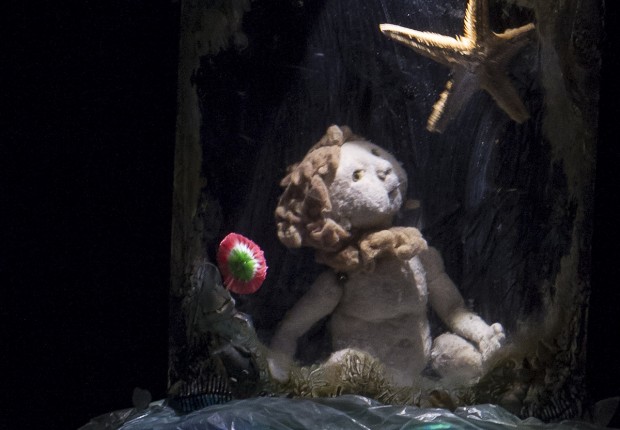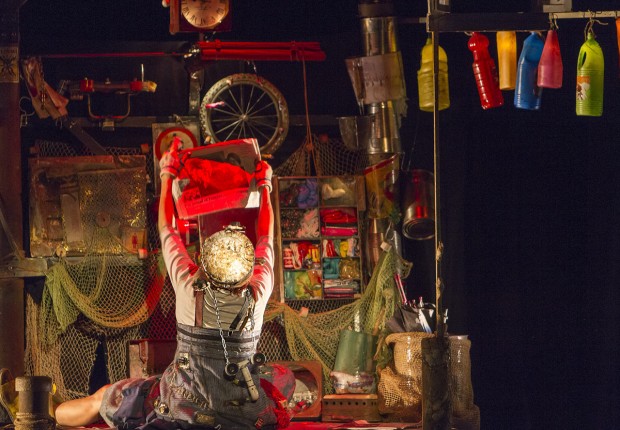A play for audienes age five and older

This educational guide is intended to serve as a guide to acquaint young girls and boys with the theatre. We prepare them for a play by reminding them of the importance of knowing what they are about to see and commenting on the story with them. Primarily, it arises from the need to educate them as future theatregoers.
The activities we propose are intended to develop a critical attitude, the ability to evaluate, weigh, share and discuss the theme of a play according to one’s own criteria. It is important for parents and teachers to participate at home and in school by explaining the topics addressed in the play in a responsible and neutral manner.
DOCUMENTS The Play: Synopsis
A woman lives on a rusty pier outside of a city.
She fishes for what other people throw away.
One day she makes an amazing catch: a little girl in a bottle.
It gives her such a fright that she tosses the bottle back into the sea. She does not want to see the little girl. Perhaps it is because she sees her own image reflected in the bottle as in a mirror.
Her thoughts travel back in time to distant memories.
She decides to go and look for the girl but it is too late. The sea has carried the bottle away.
Even so, she still hopes she can find the girl and sets out to search for her. Perhaps she is seeking the child within herself.
First in a paper boat…
Later, in the deep sea.
THE AUTHOR
Rosa Díaz Director, actress and author
Rosa Diaz was born in Albacete in 1964. She has been engaged professionally with the theatre since 1981 and has been a member of several companies: Teatro Fénix, Johannes Vardar, Cambaleo Teatro, La Tartana and Ur Teatro .
She started the Laví e Bel in 1992, and Lasal Teatro in 1999, in the city of Granada . Currently, she directs and performs in the “La Rous”theatre company, founded in 2008, with which she has received “best play” awards for:“Grand’ather’s House” ( Fetén 2009) and “The Refuge”. The latter obtained awards for the best play and best performance (Fetén 2011). In 2011 she obtained the NATIONAL THEATRE AWARD for Children and Youth.
Rosa Díaz has directed plays for dance troupes, object theatre, puppets, street theatre and circuses, including: L`Home Dibuixat, Axioma Teatro, Karlik Danza , Gar Producciones , Vagalume Teatro , Vaivén Circo Danza , Arena en los Bolsillos and Date Danza.
CAST AND CREW
Actress: Rosa Díaz
Puppeteer: Cristina Berhó
Lighting and sound engineer Katia Moretti / Iván Monje
Playwrights. Fanny Giraud and Rosa Díaz
Scrip collaboration: Ángeles Jiménez Soria
Puppets designed and made by: Maria Sánchez
Bird puppet designed and made by: Juan García and Cía. Tuttilifamili
Puppet assistance: Maite Campos and Ariel García.
Graphics and web design: Mábiac.es
Lighting design: Katia Moretti.
Set design: Rosa Díaz
Set direction: Eskenitek S.L
Puppet direction: María Sánchez y Maruja Gutiérrez
Prop direction: Fabián Huertes Castillo
Set and props completion: Ato Teatro Producciones.
Paco Nicasio (Axioma Teatro)
Carpentry: Jose Toral
Wardrobe by Laura León.
Original score and sound space: Ivan Monje (www.jiribilla.es)
Recording studio musicians: Mele G. Ríos (Voice)
Iván Monje (Guitar, Melodic, Percussion)
Joaquín Sánchez Gil (Clarinet)
Jaime Párrizas (Marimba)
Derk Rossbach (Violin)
Photography: Gerardo Sanz/Gabriel Díaz
Video: Global Production Tv
Cast director: Fanny Giraud
Artistic direction Rosa Díaz
Production : Cía. La Rous yAgenciaAndaluza deInstituciones Culturales (AAIC)
ABOUT THE PLAY
The play uses the language of clowns to address at least four topics.
1)We talk about isolation and lonliness; of experiencing what others do not want to know; of prolonging the life of objects and recycling them creatively. We find a woman on a pier. She is alone, an outcast. She has been alone for a long time, always repeating the same things, in the same manner. She colletcts what others throw away: the trash cast ashore by the sea near where she lives. She selects bits of rubbish and transforms what she has found: that is her job.
2)How we live. Facing life
There are two well-defined paces:
The woman on the pier, a stressful pace, systematic, methodical and orderly, that forces her to make haste all the time. “I must hurry”, she mutters constantlyas she goes about her daily routine.
The Girl’s pace is slow and deliberate, giving her time to discover the world through innocent eyes.
3)An introspective view: This is more subtle and less obvious. It is to “be aware of the child within us”; to live fully in the present moment.
4) Relationship between equals. A meeting between two different people brings about a relatioship of exchange and understanding, opening a world of opportunities for listening and having respect for the world of children.
BEFORE THE PLAY
Important topics addressed in the play:
Loneliness and neglect
The relationship between adults and children. Time, pace, language.
Loneliness and Neglect
Activities are developed on one or more topics addressed in the play, according to the age of the school group. Before the play, it is a good idea to ask ourselve the following questions:
-What is loneliness? Loneliness in chilren and adults.
-Neglect as a topic for discussion. Abandonment of the things we throw away; neglect of the adult who drops out of everyday life and society in general; or of a little girl abandoned in a bottle.
-The children can identify someone in their day-to-day life, perhaps someone who walks along the street where they are playinng or who lives near their home. Have them try to discover or invent something more about that person, without being discriminating or judgemental, and without knowing who they are or their circumstances.
On the pace of life and relatioships
-Relationships between adults and children.
-The pace of life for adults and for children.

DURING THE PLAY
How should we behave when we go to the theatre?
Is a theatre the same as a football field or television?
Obviously, there are many differences. The audience’s cooperation, concentration and silence are essential.
AFTER THE PERFORMANCE
After seeing the play “The Girl”, let’s think about what drew our attention most. Let’s invent a story about our selves as though we were in the same situation as the girl or the woman who lives on teh pier.
Make a drawing of the most interesting moment the play, in your opinion, and explain why it caught your attention. Perahps you found the images on stage particularly beautiful , or it touched you in a special way. Or maybe it was what the characters were experiencing, the use of colour in the lighting, the music, or the atmosphere created by the instruments and the moments of silence.
The woman on the pier uses the objects she fishes from the sea to create and build things, and to play with them.
Imagine that you find three objects. Invent something with them. What can you do with them? What can you transform them into?
In the play, the woman decides to go out to sea in search of the girl.In which ways do you think you would look for the girl? Improvise a play about diving into the sea and what you would need to find her.
This is an open-ended play. The woman and the girl find each other but we ignore whether they will stay together or separate later. Their relatioship is based on mutual respect. and puts an end to their loneliness, neglect and isolation. They communicate in a body language that is more spiritual than ordinary speech.
Discussion. The end situation in the play raises the following questions:
-What should the relationship between adults and children be like?
-What weight should children have in the way the world is organised?
-We recommend a visit to the website: “La citta dei bambini” .
Make a mural: Children picking up trash.
-Find some pictures at home and comment on them.
-Make a mural with your findings and thoughts.
-Take the pictures and other photos that suggest other situatons related to the story told in the play.

